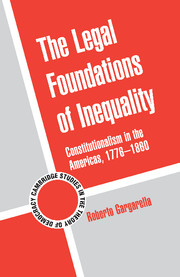3 - Liberalism: Between Tyranny and Anarchy
Published online by Cambridge University Press: 06 July 2010
Summary
The Sovereignty of the Individual
Liberal theory had a decisive influence on the development of American constitutionalism. Compared with the radical and conservative alternatives, it soon appeared an attractive option. In order to achieve this privileged position, liberals insisted on demonstrating the differences that separated their view from the two main alternatives present at that time. In some cases, they pointed to the past and highlighted the social violence and the political authoritarianism that distinguished the postrevolutionary years: liberalism, they promised, would prevent these situations from happening again. On other occasions, they simply announced the consequences that seemed to follow on from the adoption of rival positions.
Liberals were clever enough to identify the alternative conceptions with their most extreme and unacceptable features and to present their own conception as an ideal mediating position. The chief expression of this view was that which asserted the need for preventing the evils of tyranny and anarchy. Liberals such as James Madison argued that it was necessary to adopt a completely new set of institutions in order to ensure peace and social progress. The influential Mexican José María Mora also made reference to the importance of preventing both the absolutism of the despot and the tyranny of the majority. The Argentinean caudillo Justo José de Urquiza, the politician mainly responsible for the enactment of the 1853 constitution, demanded the adoption of “a Constitution that made impossible both anarchy and despotism.”
- Type
- Chapter
- Information
- The Legal Foundations of InequalityConstitutionalism in the Americas, 1776–1860, pp. 153 - 214Publisher: Cambridge University PressPrint publication year: 2010

